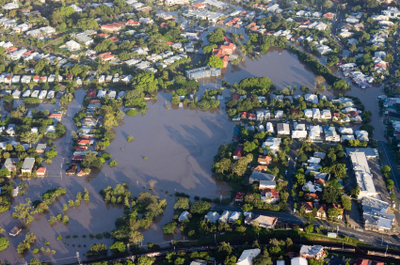
Wharton study proposes innovative ways to improve government-funded flood insurance.
The catastrophic flood damage caused by Hurricane Katrina in 2005 and Hurricane Irene in 2011 highlighted the importance of federal flood-related disaster assistance. However, according to a recent study released by the Wharton Center for Risk Management and Decision Processes, there are a number of problems with the federally managed National Flood Insurance Program (NFIP), which could potentially be addressed by a partial or complete privatization of flood insurance in the United States.
The study, prepared by Jeffrey Czajkowski, Howard Kunreuther and Erwann Michel-Kerjan, analyzes riverine and storm-surge flooding in two Texas counties to determine risk-based premiums for flood insurance. Premiums reflecting risk would provide the foundation for flood insurance delivered via a private market, a reform option currently on the policymaking table.
The FEMA risk classification system labels zones of land within a spectrum of low to high risk. The risk classification of a zone is calculated by averaging the total risk within the entire zone. This classification is applied uniformly across each zone, without taking the risk variance across individual properties into account. According to the study, the substantial variation of flood risk between individual properties reduces the accuracy of these classifications, resulting in large discrepancies of risk between zones which have similar risk classifications.
The study’s authors suggest that existing NFIP insurance premiums are sometimes higher and sometimes lower than the risk-based premiums generated from their analysis. For example, in Travis County the NFIP on average underprices high risk flood zones and overprices moderate and low risk flood zones, which might encourage property owners in high risk flood zones to purchase flood insurance while potentially making property owners in low risk flood zones less likely to purchase insurance. The resulting disproportionate coverage of high risk properties potentially increases the risk of fiscal insolvency in the event of a catastrophic natural disaster.
According to the study, one potential method of addressing this disproportionate coverage is to encourage private insurers to offer flood insurance to complement NFIP coverage. Private insurers could provide risk-based coverage and the resulting increase in aggregate insurance coverage would reduce necessity of federal relief in the incidence of natural disaster.
The study suggests that complete privatization of flood insurance is unlikely in the near future given, among other things, the regulatory constraints on the industry that limit insurers ability to price based on risks. However, along with suggesting the need for better efforts to mitigate risks, the study lends some reason to think that encouraging private insurers to provide flood coverage could address some of the current inefficiencies of the NFIP.
Two co-authors of the study, Kunreuther and Michel-Kerjan, are affiliates of the Penn Program on Regulation.



